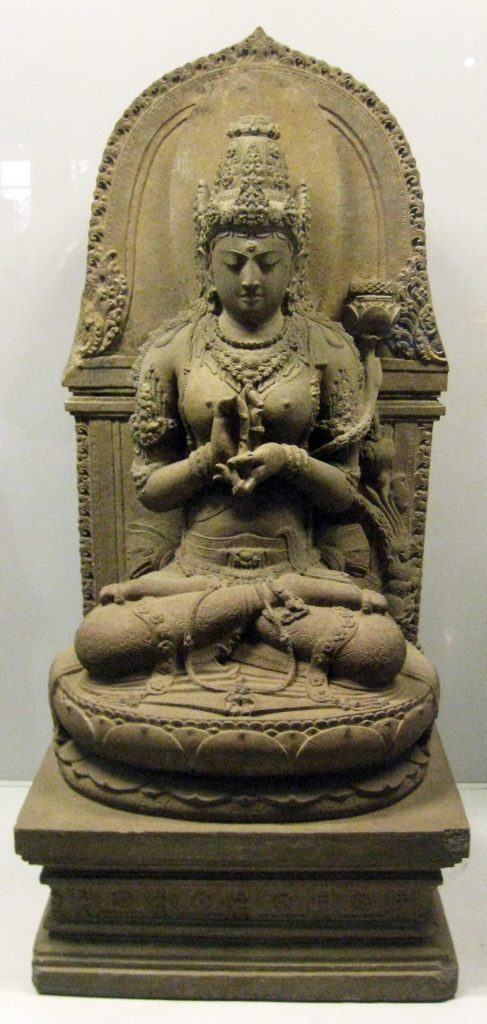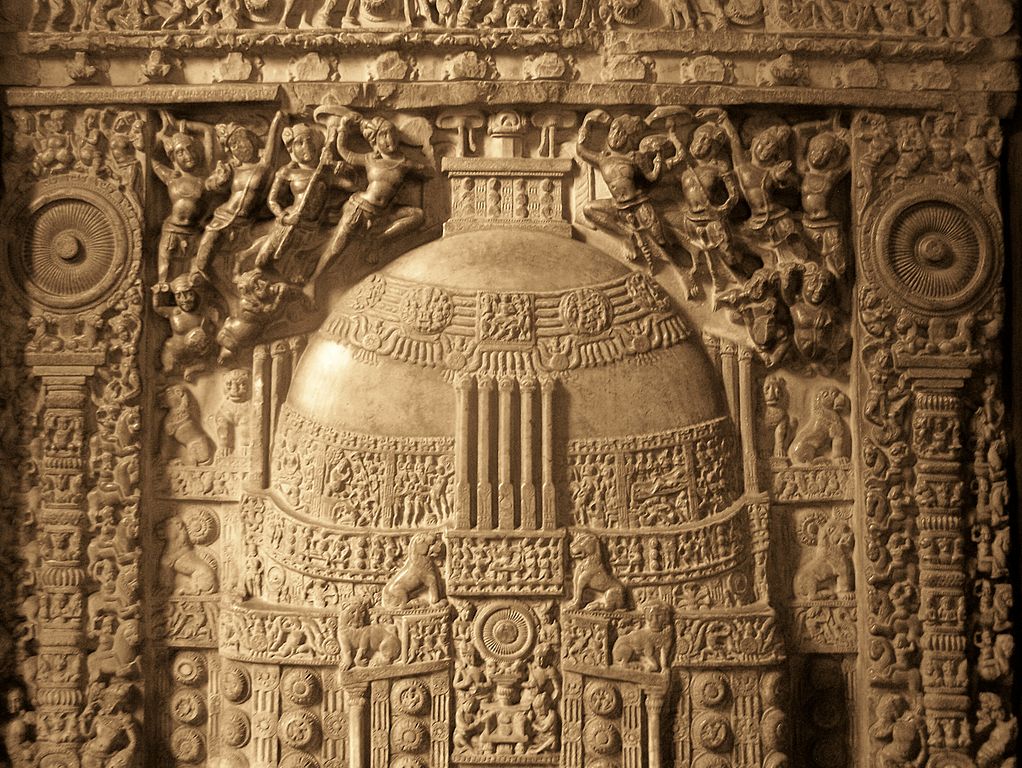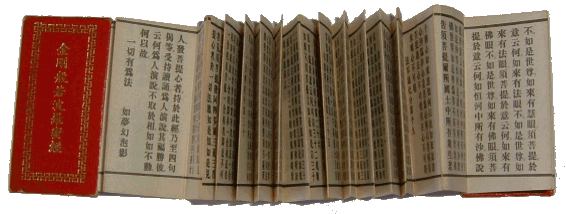Perfection of Wisdom: “inexhaustible tenderness and diamond clarity” (Lex Hixon)
Origins of the Prajnaparamita Sutras

Three or four centuries separate the death of the Buddha in 486 BCE, or 368 BCE – whether you follow the Southern (Singhalese) tradition, or, as a growing number of scholars now favour, the Northern (East Asian) tradition – and the emergence in writing of the Perfection of Wisdom (Prajnaparamita) in 8,000 Lines, the first of the Prajnaparamita Sutras dated 100 BCE. During these centuries, Buddhism evolved from a set of teachings given by a master to an assembly of disciples to an organised religious institution for the lay community in successive political contexts, in particular during the reigns of Asoka (c. 268-232 BCE), the Greco-Bactrian Kingdoms (250-125 BCE) and the Indo-Greek kingdoms (180 BCE-10 CE) founded by Greeks after Alexander the Great’s short occupation of the region. The period Edward Conze has described as that during which the original basic text was expanded into larger versions – 18,000, 25,000 and 100,000 Lines – coincided with a new flourishing of Buddhism under the Kushan empire (30-375 CE) as well as the start of its transmission to China along the Silk Road, said to have begun in the first centuries of the common era.
There seems to be a common assumption that the earliest Buddhist texts are those of the Pali Canon compiled by the Theravada School, but these, just as the Prajnaparamitra sutras, were put in writing during the first century BCE, and the Theravada School itself only emerged as a separate school following a schism which took place during the Second Buddhist Council held at Vaisali around the time of Asoka: a group of monks proposed the addition of stricter rules to the Vinaya (monastic code of discipline) and refused to accept the majority decision against that proposal, preferring to create a separate school, originally called Sthaviravada (meaning “Doctrine of the Elders”), but now known as Theravada.

The majority group which had opposed the stricter rules came to be known as the Mahasamghikas (meaning the “Great Samgha”). Even though Mahayana as a movement cannot be associated with any particular school, it is in a Mahasamghika monastery in Amaravati (Andhra Pradesh) that the oldest manuscripts of the Perfection of Wisdom in 8,000 Lines were found. So the conservative “Elders” did not precede the more liberal Mahasamghikas, but instead developed in reaction to them, as those who gave precedence to the letter of the teaching, while the Mahasamghikas and other progressive schools took the compassion-based teaching career of the Buddha as embodying the true spirit of Buddhism. As the latter were more willing to innovate in their teaching methods in order to adapt to new cultural contexts, they were able to give rise to a universal religion spreading beyond the borders of India, while Theravada remained the mainstream Buddhist practice within India. This being said, the founding texts of the Mahayana – that is, the Prajnaparamita Sutras, Nagarjuna’s Madhyamika writings, as well as a number of other Mahayana sutras – were composed in India, even if some of them have come to be better known in their Chinese translations.
The teachings expounded in the Perfection of Wisdom texts are presented as advanced teachings given by the Buddha in his later years to disciples such as Sariputra – “foremost in wisdom” among the Buddha’s disciples – and the venerable Subhuti, whose name means “born of emptiness.” They were, just as the Theravada sutras, transmitted orally for many centuries before being written down. There is a tradition which holds that the Prajnaparamita sutraswere not among the texts recited during the First Buddhist Council, shortly after the death of the Buddha. Conze argues that they were instead transmitted esoterically from teacher to disciple until a large audience capable of understanding them had emerged.
Paul Williams explains that, in the past it was widely held that the Perfection of Wisdom in 8,000 Lines, also known as Astasahasrika Prajnaparamita Sutra, was composed in the Amaravati monastery. This, though confirmed by a comment on the sutra, has been thrown into doubt by a few scholars among whom Etienne Lamotte, and A. L. Basham, who argue for a north-western or even Khotanese location, where Greek influences would have been at work. The text indeed had a great success in that region at the height of the Kushan period (2nd century CE), but – Conze argues – there is no evidence that it originated there. Basham agrees that even though the belief in heavenly Bodhisattvas is “definitely northern,” the philosophical ideas may have originated in the south. And this also applies to Nagarjuna whose Mulamadhyamakakarika has given the Prajnaparamita texts their philosophical sub-text, as he also lived and wrote in the same Amaravati monastery some time between 150 and 250 CE.

According to Edward Conze’s classification, following the expansion of the basic Prajnaparamita text into larger versions, came, from 300 CE onwards, the composition of shorter texts among which the Perfection of Wisdom in 300 Lines, better known as the Diamond Sutra, and the Heart Sutra in one page only. Again, though this classification has been widely accepted by scholars, Japanese scholars as well as Gregory Schopen have argued that the Diamond Sutra was composed and transmitted orally before the Astasahasrika which would then be a reworking of the Diamond Sutra’s core teachings. As Red Pine remarks in his translation of the Diamond Sutra, this would make sense as the teacher in this sutra is the Buddha, who brings Subhuti to a very moving enlightenment, while in other texts, Subhuti is presented as the teacher.
A book embedded in religious practice
If you have ever ventured to open a copy of the Diamond Sutra, intrigued by the popularity of this text in Asia, you have most probably felt frustrated by its repetitive style, as you first force yourself to read every line from beginning to end, and then find yourself skipping groups of words, eagerly looking for “what’s new” in any particular chapter. Williams explains why: “The book is not a free-standing, self-explanatory item, but an entity embedded in religious practice, a product of and a guide to spiritual experience … The text would be copied and read, but reading was perhaps closer to chanting out loud.” It would “be learnt by heart.”Before writing was used to record religious texts, early sutras had to committed to memory before being transmitted orally. Additionally, parts of a sutra were often written in verses, though Chinese translations did not replicate the verse format. It is clear that the Prajnaparamita sutras were not meant to be read in the way we now read books. They were meant to be recited, often in unison with other monks. This should be remembered when studying their style, and the way they imprinted the vision of a dream-like world, empty of solid entities, upon the minds of the practitioners, not, as we will see, to throw them into a bottomless void, but “to dismantle the hard categories we impose upon reality, to reveal the eternal flowing possibility in which the Bodhisattva lives”(S. Beyer quoted by Williams).
Perfection of wisdom: negating one’s way to liberation
As Williams put it, Prajnaparamita texts do not “indulge in elaborate philosophical argument.” They were, however, written “from the perspective of perfect wisdom … wherein absolutely nothing has any independent final ultimate existence, but remains only in terms of conceptualized pragmatic conventions. All entities are like hallucinatory objects.” They are, as Nagarjuna later elucidated in philosophical terms “empty of intrinsic existence” (svabhava). Subhuti says in the Astasahasrika: “Even Nirvana, I say, is like a magical illusion, is like a dream. How much more so anything else! (Conze Translation of the Astasahasrika quoted by Williams).
Williams insists that “This is not some form of monistic absolutism, a via negativa negating in order to uncover a True Ultimate Reality. The ultimate truth is that there simply is no such thing as a True Ultimate Reality, and the sooner we let go of such a thing the better.”
This is, in fact, what differentiates prajnaparamita (perfect wisdom) from ordinary paramitas (perfections) which the Theravadins also cultivated. The latter were listed as either 6 or 10, with 6 paramitas more common in Mahayana: giving (dana), morality (or precepts, sila), endurance (ksanti), exertion (virya), meditative concentration (dhyana), and wisdom (prajna). Commenting on the Diamond Sutra, Red Pine quotes Lin-chi saying: “By not dwelling on anything, bodhisattvas do not see the self that gives, nor do they see the other that receives, nor do they see anything given. For all three are essentially empty. By concentrating without concentrating on anything, their practice of charity remains pure.” Prajnaparamita requires that the act of giving, the gift itself, and the person who receives the gift be “emptied,” that is, not even conceptualised in the mind. We could call this type of giving un-self-conscious giving, a giving without congratulating oneself on how charitable one is, let alone expecting anything in return.
It is clear that by including the self-emptying of the paramitas and, in general, the self-emptying of all aspects of the bodhisattva practice, Mahayana considerably extended the role played by emptiness in the process of liberation. Though some non-Mahayana schools had also extended the teaching of “no own being” from the absence of self in the person to the absence of “intrinsic existence” in all dharmas, thereby refuting the doctrine that posited “dharmas” as substantial building blocks of the things we see – not unlike atoms – the universal emptiness of all things is presented in all Mahayana schools as one of their core doctrine.
This emphasis on the absence of “intrinsic existence” in all “things” does not, however, mean that “things” do not exist. Lex Hixon, who published a translation of 40 passages of the Astasahasrika, argues that “Lacking such static essence or substance does not make them not exist – it makes them thoroughly relative, there is no limit to their being creatively reshaped by enlightened love. So the via negativa of the Prajnaparamita does not annihilate things; it frees them from entrapment in negativity, opening them up to a creative relativity.”
This, Hixon says, is the realisation Tsong kha pa describes as his long awaited enlightenment which he movingly describes in his writings. Williams also regards Tsong kha pa (1357-1419) as being closest to the teaching of the Mahayana. As we come to see all “things” as conceptual forms produced by our minds, we not only cut our attachment to them as a reality as it were, set in stone, but we feel free to engage into “new avenues of understanding,” “liberating thoughtways that launch the understanding beyond its constricting cultural and even instinctual preconditioning.”

There is a sentence in the Diamond Sutra that is repeated so many times that it is thought to be the gatha encapsulating the project behind the whole sutra which, at some point, the Buddha hints at, without explicitly formulating it. This sentence is as follows: “No one can be called a bodhisattva who creates the perception of a self or who creates the perception of a being, a life, or a soul.” As he teaches to liberate others, the Bodhisattva is asked to use words without positing these as referring to substantial entities. When, to be grammatically correct, we say “I” though we know that there is no “I,” and use the word “to be” while denying that there is any “being,” we do give the impression that both “I” and “am” represent really existent entities. This seems unavoidable, but the authors of the Prajnaparamita sutras did try hard to avoid it, thereby emulating the bodhisattva!
So, it can be said that perfect wisdom is not a via negativa to recover ultimate reality, in the sense of a brahman-like unchanging being or order, which we can only comply with. Neither can it be said that it is a via negativa to recover an ultimate reality in the sense of a reality that would be “emptiness.” Because that would turn emptiness into “a thing called emptiness.” Perfect wisdom is the very dynamic of self-emptying, whereby we are set free from the “things” we ourselves have created, and can now flow with life as it unfolds moment to moment, creatively encountering reality in its impermanent phenomenal aspects without hankering after a permanent, solid substratum that would be really (substantiality) real. In that sense, I feel that every single repetition about the dreamlike nature of things, is, as liberation a step towards an encounter with reality that is positive, and in that sense, there is in these early Mahayana texts a paradox: a negative action leads to a positive state of mind. I would not say, however, that there is already in the Prajnaparamita sutras the vision of “a universe in which phenomena have been not only restored to a measure of respectability, but indeed have become important, valuable, and lovely,” that is found in the much later development of the Chinese Huayan School. (Francis H. Cook, quoted by Jin Y Park).
“A union of inexhaustible tenderness and diamond clarity”
What the Prajnaparamita sutras do beautifully, however, is to merge the Buddha’s practice of self-emptying with the compassionate dimension of the Bodhisattva Vow to save all beings, embodied in the tender figure of the “Wisdom Mother,” as Hixon calls Prajnaparamita. Self-emptying is not a renunciation to one’s ego-self, it is an opening up of the heart, and with it, access to intuition. “The response that the sutra subtly generates in our awareness is not step-by-step reasoning but existential intuition, ineffable and direct.” (Hixon). It is no accident that wisdom is represented by a motherly figure. Likewise, a feminine figure, Sophia, represents wisdom in Christianity. Contrary to what has been, and still is being claimed today, feeling is not a hindrance to an intelligent understanding of reality, but its condition. “Sensitive, loving concern and compassionate action become the arena for the most radical, transcendent wisdom” (Hixon). Feeling is intuition, and intuition is clarity. “Mother Prajnaparamita expresses her mystic motherhood equally and perhaps more centrally as the uncompromising discipline of transcendent insight. A union of inexhaustible tenderness and diamond clarity that is like open space radiates from this Sutra as the strong feminine voice of Prajnaparamita” (Hixon).
Sources
Lex Hixon – Mother of the Buddhas – Meditation on the Prajnaparamitra Sutra (1993)
Paul Williams – Mahayana Buddhism: The Doctrinal Foundations 2nd edition (2009)
Red Pine (Bill Porter) – The Diamond Sutra – Texts and Commentaries translated from Sanskrit and Chinese (2001)
Jin Y. Park – Buddhism and Postmodernity – Zen, Huayan, and the Possibility of Buddhist Postmodern Ethics (2008)

